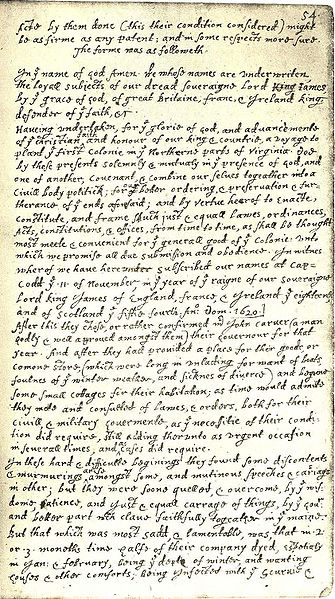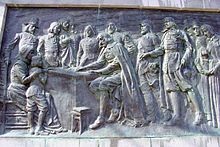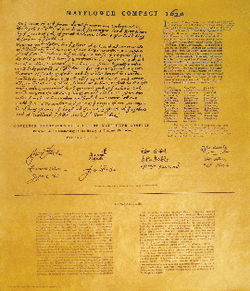The Mayflower Compact was the foundational document for the Plymouth Colony. The fact that it was a covenant whereby the settlers would subordinate their rights to follow laws passed by the government to ensure protection and survival made it a unique document. As previously stated, it set a precedent and was indeed an influential document for the founding fathers as they created the US Constitution.
A list of 41 male passengers who signed the document was supplied by Bradford's nephew Nathaniel Morton in his 1669 New England's Memorial. Thomas Prince first numbered the names in his 1736 A Chronological History of New-England in the form of Annals.Because the original document has been lost, Morton (1669) is our sole source for the signers. Although he probably had access to the original document, he could not have known simply by inspecting it the actual order that it was signed. Morton's arrangement of names is probably not the arrangement of names on the original document, and the names may not have been arranged in any orderly fashion. Prince's numbers are based solely on Morton (1669) as he himself stated. His numbers are unfortunate because he could not have known the order that the original document was signed.
Morton's list of names was unnumbered and untitled in all editions although their order changed with successive editions. In his original 1669 edition, the columns were placed on two successive pages (15–16) forming six short columns, three columns of seven names each (headed Carver, Samuel Fuller, and Edward Tilley) on the first page and three columns of seven, seven, and six names each (headed Turner, Priest, and Clarke) on the next page.
A list of 41 male passengers who signed the document was supplied by Bradford's nephew Nathaniel Morton in his 1669 New England's Memorial. Thomas Prince first numbered the names in his 1736 A Chronological History of New-England in the form of Annals.Because the original document has been lost, Morton (1669) is our sole source for the signers. Although he probably had access to the original document, he could not have known simply by inspecting it the actual order that it was signed. Morton's arrangement of names is probably not the arrangement of names on the original document, and the names may not have been arranged in any orderly fashion. Prince's numbers are based solely on Morton (1669) as he himself stated. His numbers are unfortunate because he could not have known the order that the original document was signed.
Morton's list of names was unnumbered and untitled in all editions although their order changed with successive editions. In his original 1669 edition, the columns were placed on two successive pages (15–16) forming six short columns, three columns of seven names each (headed Carver, Samuel Fuller, and Edward Tilley) on the first page and three columns of seven, seven, and six names each (headed Turner, Priest, and Clarke) on the next page.



